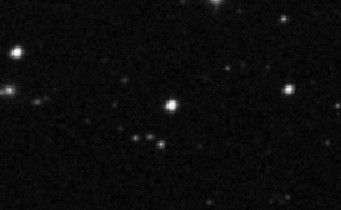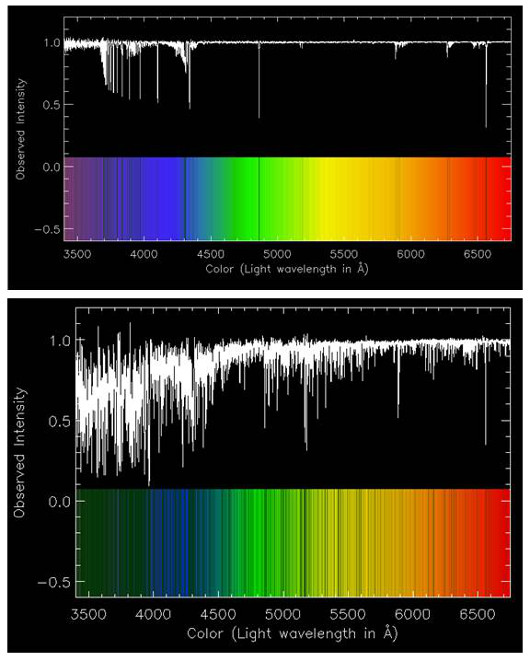Astronomers have discovered the purest star to date. Composed almost exclusively of hydrogen and helium — with 15 million times less iron than our Sun — it illuminates what happened among the first supernovae in the early universe.

SM0313 — the fuzzy blob in the center of this image — is located 6,000 light years away in the constellation Hydrus.
Sloan Digital Sky Survey
The young universe was virtually pure. Only hydrogen, helium, and a tiny trace of lithium emerged from the Big Bang nearly 13.8 billion years ago. And for hundreds of millions of years the universe was too hot to handle anything else.
But over time the universe cooled and giant clouds of the primordial elements collapsed to form the first stars. Without traces of heavier elements available to cool the gas clouds, the first “Population III” stars were extremely massive and bright, erupting as supernovae after relatively short lifetimes of just a few million years. These explosions, in turn, began seeding the young universe with heavier elements.
The cycle of star birth and death has steadily produced and dispersed more heavy elements throughout cosmic history, providing the substances necessary for rocky planets and intelligent life.
In astronomical circles we refer to all elements heavier than helium as “metals.” The older a star is, the less contaminated it was at birth, and the fewer metals visible in its spectrum today.
The elements we see lacing a star’s surface provide a key to understanding the supernovae (and other heavy-element factories) that preceded the star’s birth. The Sun, for example, is metal-rich, with roughly 1.4% of its mass composed of elements beyond hydrogen and helium. Having formed only 4.6 billion years ago (two thirds of the way from the Big Bang to now) the Sun sprang from multiple generations of earlier stars which produced and blew off heavier elements.
But a few truly ancient stars remain: unassuming low-mass ones hidden among the millions of newer stars swarming the Milky Way. Their low metallicity betrays them, and astronomers have been patiently scanning the skies in search of them.
Now an international team of astronomers has discovered a record-breaking pure star — at least as measured by its low abundance of iron — located 6,000 light-years away in the southern constellation Hydrus. Its slightly odd colors flagged it among the 60 million other stars photographed by SkyMapper, a 1.35-meter sky-survey telescope in Australia, in its first year of operation. The team then took high-resolution spectra with the 6.5-meter Magellan Clay telescope in Chile.
Chemically, this star — known as SMSS J031300.36-670839.3, or SM0313 for short — is the purest discovered to date, with 15 million times less iron than is in our Sun.
And that’s just an upper limit. SM0313 is remarkable for the complete absence of detectable iron lines, writes lead author Stefan Keller (Australian National University). The star shows only four elements beyond hydrogen and helium: lithium, carbon, magnesium, and calcium, all of which are relatively light, and barely present in the star.
Astronomers use the Sun as a baseline for metallicity. So an iron/hydrogen ratio (denoted [Fe/H]) of zero is solar. Negative values are metal poor compared to the Sun; and positive values are metal-rich. To make it more complicated, they’re expressed logarithmically.
The previous record holder had an iron abundance of [Fe/H] = –5.6, or 400,000 times less than the Sun’s iron. SM0313 has an iron abundance of no more than [Fe/H] = –7.2, or 15,000,000 times less than the Sun’s. That’s almost 40 times lower than the most iron-starved star previously known.
Interestingly SM0313 has much more carbon, with a [C/Fe] of at least +4.5, or at least 30,000 times more carbon than iron as compared to the Sun. So SM0313 belongs to a class known as carbon-enhanced, metal-poor stars.

The upper spectrum is SM0313. The strong lines are from hydrogen (4861Å and 6560Å) and carbon (4300Å), as well as from the Earth's atmosphere (5800Å and 6300Å). The lower spectrum is a metal rich star for comparison. The spectrum of the Sun would have even more absorption lines due to heavy elements.
Courtesy of Anna Frebel
Such drastically low iron and less-low carbon suggests this star was enriched by a single Population III supernova in the early universe. It is thus a second-generation star, nearly as old as the universe itself.
Prior to this discovery, astronomers believed the very first stars died in super-violent “hypernova” explosions that rapidly enriched huge volumes of space with iron. But SM0313 suggests that not all first generation supernovae were so extreme.
Computational models do show that the progenitor was likely a massive star, weighing 60 times the mass of our Sun. After 3 million years it exploded and flung away the moderately light elements in the outer layers of its shell. The explosion, however, was not forceful enough to release the heavier contents of its inner layers, which collapsed into a black hole — trapping the expected iron.
This low-energy supernova would have exploded with the same energy as the famous SN 1987A in the Large Magellanic Cloud. But SN 1987A was only 18 times the mass of the Sun, so for a 60-solar-mass star, this energy would have been abnormally weak.
Its carbon-enhanced, iron-poor blast wave must have then helped SM0313 to coalesce quickly nearby, as there seem to be no contributions from other supernovae.
This was also unexpected. Typically we would expect star-forming sites to be huge and influenced by multiple supernovae, preventing the single-blast abundance pattern we see in SM0313.
While some have called SM0313 the oldest known star, we can’t actually determine an exact age, says coauthor Anna Frebel (Massachusetts Institute of Technology). A record-breaking age is not the takeaway message here.
Rather, the star provides a bold new look into the first supernova explosions that seeded surprisingly light elements into the young universe. “It’s very exciting that we can establish SM0313 as a second-generation star,” says Frebel.
The iron-starved star has started to expose a story nearly lost more than 13 billion years ago.
References:
S. C. Keller et al. “A single low-energy, iron-poor supernova as the source of metals in the star SMSS J 031300.36-670839.3” Nature, 2014
 1
1
Comments
Anthony Barreiro
February 20, 2014 at 3:22 pm
That's a pretty clean spectrum, and this is is a remarkably clear and intelligible report, even for an amateur with only a rudimentary understanding of cosmology and stellar evolution. Given that this ancient star is in Hydrus, I won't be able to see it from my California backyard, but I'm curious how bright it is.
You must be logged in to post a comment.
You must be logged in to post a comment.